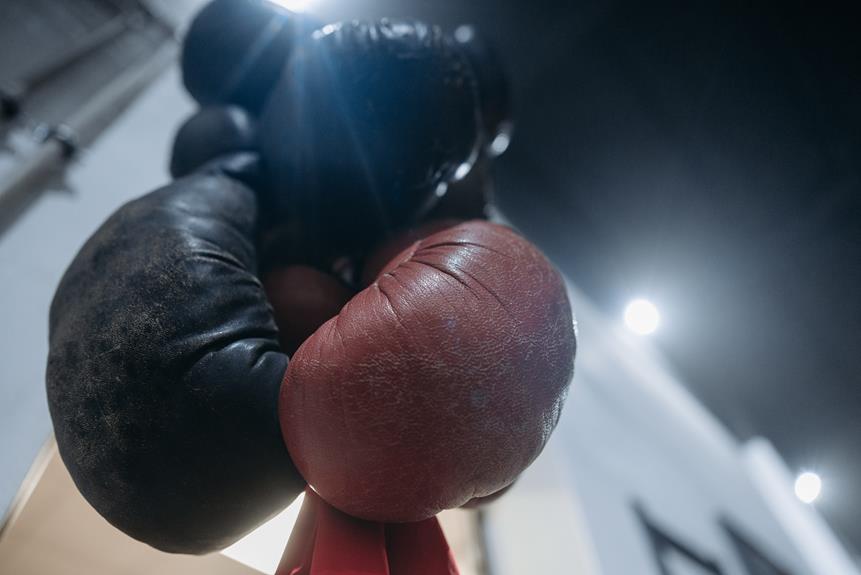Liver shots in MMA and boxing are devastating strikes that strike fear into the hearts of opponents. Like a precision-guided missile, these targeted blows aim for the vulnerable organ nestled beneath the ribcage. The excruciating pain and breathlessness they inflict leave fighters defenseless, their energy drained.
With techniques ranging from hooks to kicks, liver shots have a reputation for delivering knockout blows. In this article, we delve into the anatomy, execution, defense, and potential risks of these merciless strikes, shedding light on why they are both feared and respected in the world of combat sports.
Key Takeaways
- Liver shots in MMA and boxing target the liver, located on the right side of the stomach, and can cause extreme pain, impaired breathing, and an inability to defend oneself.
- Liver shots accumulate damage, drain a fighter's energy and strength over time, and may result in a knockout rather than a technical knockout.
- The liver is vulnerable in combat sports due to its exposure and lack of protection, making it a prime target for strikes.
- Liver shots can be executed with various techniques such as left hooks, shovel hooks, roundhouse kicks, front kicks, ground-and-pound, and knees in the clinch.
The Anatomy of Liver Shots
The liver, located on the right side of the stomach under the ribcage and below the diaphragm, is the target of liver shots in MMA and boxing. Liver shots are strikes aimed at this vital organ, causing extreme pain, impaired breathing, and an inability to defend oneself.
Common liver shot combinations include left hooks, shovel hooks, roundhouse kicks, front kicks, ground-and-pound, and knees in the clinch. To effectively target the liver, fighters can employ various training methods such as practicing front kicks and shovel hooks with precision and power.
Additionally, improving footwork, using feints, and setting up liver shots with combinations, particularly targeting the head first, can enhance the chances of landing successful liver shots. It is crucial to develop a high and tight guard, improve body movement, and utilize good footwork to defend against liver shots.
The Impact and Pain of Liver Shots
Liver shots deliver a forceful impact and cause excruciating pain to the targeted organ. The impact of a well-executed liver shot can be devastating, leaving the recipient incapacitated and unable to continue fighting. Here are some key points to understand about the impact and pain of liver shots:
- Recovery time after a liver shot:
- Fighters hit with a liver shot often need several minutes to recover before getting back on their feet.
- The pain from a liver shot can be intense and debilitating, requiring sufficient time for the body to recover and regain its strength.
- Strategies for landing liver shots effectively:
- Fighters can target the liver with techniques such as left hooks, shovel hooks, roundhouse kicks, front kicks, ground-and-pound, and knees in the clinch.
- Feints and combinations can be used to set up liver shots, with the first punch typically targeting the head in boxing.
- Proper timing, accuracy, and positioning are crucial for successfully landing liver shots and maximizing their impact.
Understanding the recovery time required after a liver shot and implementing effective strategies for landing liver shots can give fighters a significant advantage in combat sports.
Execution and Techniques of Liver Shots
Effective execution and mastery of various striking techniques are essential for landing devastating liver shots in MMA and boxing.
Fighters employ different strategies for setting up liver shots, aiming to exploit their opponents' vulnerabilities and create openings.
In MMA, front kicks and shovel hooks are particularly effective for targeting the liver. The front kick allows fighters to create distance and generate power to strike the liver with their foot.
The shovel hook, a punch specifically designed to target the liver, is commonly used in boxing. Fighters in boxing often use feints and combinations, with the first punch typically targeting the head, to set up liver shots.
Defending Against Liver Shots
One effective way to defend against liver shots is by maintaining a strong and well-guarded stance. This involves keeping the hands up to protect the body, particularly the liver area, and having the elbows tucked in close to the body.
In addition to a strong stance, there are specific counter techniques and training strategies that can be employed to defend against liver shots:
- Counter techniques against liver shots:
- Clinching: Clinching is a technique that involves grabbing onto the opponent's body to control their movements and prevent them from delivering liver shots.
- Parrying: Parrying is a defensive technique where the fighter uses their hands or arms to redirect or deflect the incoming liver shot.
- Blocking: Blocking involves using the arms or forearms to absorb the impact of the liver shot, reducing the damage inflicted.
Training strategies for defending against liver shots:
- Conditioning: Strengthening the core muscles, particularly the abdominal muscles, can help absorb and withstand liver shots.
- Sparring: Regular sparring sessions allow fighters to practice their defensive skills against liver shots and develop their reflexes.
- Footwork: Good footwork allows fighters to move quickly and avoid being in positions where they are vulnerable to liver shots.
Understanding the Science Behind Liver Shots
Compressing and stretching the liver upon impact, striking the liver in MMA or boxing causes pressure on the vagus nerve, triggering a series of physiological responses. This pressure leads to the activation of the body's survival response, which includes widening blood vessels, decreasing heart rate, and dropping blood pressure.
Additionally, the impact on the liver releases pain-inducing chemicals into the bloodstream, resulting in impaired breathing, weakness, nausea, and intense pain. The body instinctively forces itself into a horizontal position to maintain blood flow to the brain and control blood pressure.
Understanding the science behind liver shots is crucial for both fighters and trainers to develop effective strategies for countering them. By studying the physiological response to liver shots, fighters can learn to protect themselves and minimize the impact of these devastating strikes.
Risks and Potential Consequences of Liver Shots
Liver shots in MMA and boxing present significant risks and can potentially lead to severe consequences for the recipient. It is important to understand the potential dangers and consequences associated with liver shots in combat sports.
Here are some key points to consider:
- Liver shot fatalities:
- While liver shots have not directly caused deaths in MMA or boxing, severe liver trauma can be life-threatening.
- Rupturing or severe internal bleeding in the liver can lead to death if not treated promptly.
- Medical treatment for liver shots:
- MMA and boxing have strict regulations and medical personnel present at events, reducing the risk of death from liver shots.
- Immediate medical attention is necessary in cases of severe liver trauma to prevent complications and ensure proper treatment.
- Better imaging and improved intensive care management have significantly decreased deaths resulting from liver trauma in MMA.
Understanding the risks and potential consequences of liver shots highlights the importance of safety measures and prompt medical intervention in combat sports.
Conclusion
In conclusion, liver shots in MMA and boxing are devastating strikes that target the vulnerable organ located beneath the ribcage. These strikes can cause excruciating pain, hinder breathing, and drain a fighter's energy over time.
While legal and acknowledged as effective techniques, severe liver trauma can be life-threatening if not promptly treated. The potential risks associated with liver shots highlight the importance of proper defensive techniques and prompt medical attention to ensure the safety and well-being of fighters.
- 15 Best Martial Arts Weapons (Fighting & Training) - October 14, 2024
- Is Fencing a Martial Art? (Yes, 4 Reasons Why) - October 14, 2024
- 7 Best Martial Arts for Self-defense Ranked (Highly Effective) - October 14, 2024










